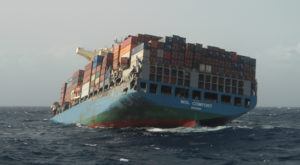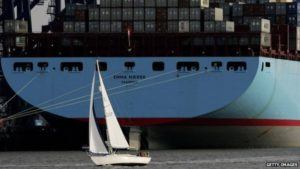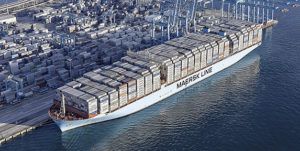Maersk: Shipping’s Unique Relationship with Climate Change

Can a 400 meter ship that carries 18,000 semi-truck-sized containers reduce its carbon footprint? How a shipping company is striving for sustainability and how it needs to position itself amidst a changing environment.

Ninety percent of world trade is transported by sea. This translates to over 5,000 massive container vessels transiting the vast, salty sea lanes annually.[1] Maersk Line, a business unit of Maersk, is the largest provider of these shipping services world-wide.[2] Shipping companies such as Maersk are intimately linked to climate change in two major ways. The first way is through CO2 emission: ships burn fuel for power and contribute CO2 and other emissions to the atmosphere. The great news is that Maersk is taking large steps to reduce its carbon footprint significantly.[3] In fact, a Maersk container ship is one of the most carbon emission efficient methods of transportation, producing only 3 G/ton-km (compared to 485 G/ton-km for an airplane and 80 G/ton-km for a truck).[4] Furthermore, Maersk has pledged to continue striving for significant CO2 reductions in the future through robust sustainability plans.[5] The second way climate change affects Maersk is through the associated environmental changes, such as the increase in frequency of severe weather, that Maersk must endure to remain competitive. These challenges present a significant threat to Maersk’s operations and must not be ignored.
While the reduction of CO2 equivalent emissions is vital to the sustainability of our planet, the climate changes that come with greenhouse gas effects is, at this point, inevitable.[6] Specifically, according to scientific and economic journals, increasing arctic temperatures and rising sea levels are “virtually certain”; increased weather intensity is “likely.”[7] Shipping companies are particularly exposed to these effects given their global port distribution, 72 ports and terminals in 69 countries on five continents, and their ability and proclivity to move vast distances around the globe.[8] These effects will have multiple implications on the operating model of Maersk.

The most obvious implication is the physical risk of the ship and its cargo associated with traversing the high seas in extreme weather. The greater the frequency, the higher the probability of damage to ships or cargo. This equates to higher costs for Maersk. At a strategic level, Maersk will have to make capital investments to insure against such events. For example, it may prove beneficial for Maersk to invest in state-of-the-art weather systems that provide real-time, global weather coverage with associated severity estimates in order to assess the riskiness of a given shipping route that Maersk intends to execute. Secondly, the increase in frequency of major natural disasters will significantly impact the logistics of Maersk. When a natural disaster hits a port, it could potentially cause so much damage that the port becomes inoperable. For example, Hurricane Katrina caused over $250 million dollars of damage to the Port of Gulfport and the in port ships and cargo.[9] Port closures or damages could have rippling negative effects in the global supply network because the movement of ships, which move the massive supplies of basic economic staples such as oil and food,

would be curtailed. Maersk will have to be equipped to deal with these crises more frequently. Finally, rising sea levels could potentially cause more frequent port flooding and threaten the existence of the current infrastructure. Although Maersk does not own port logistics, the costs associated with having to deal with these complications (e.g. delays, loading inefficiencies, etc.) will be a substantial.
Finally, in my opinion, the most thought-provoking effect climate change will have on the shipping industry comes in the form of changing economic trade landscape and shifting shipping lanes. As climates change around the globe, the local suitability of food production will substantially shift from equatorial climates to higher and lower longitudinal climates.[10] Since food is a major product transported by Maersk, this could vastly alter their economic trade channels.[11] Furthermore, looking far into the future, as polar ice caps melt, new arctic shipping lane openings may become available that could potentially significantly reduce the distance needed to travel between continents, again further altering the economic trade channels. According to the US Navy’s Arctic strategy, the Arctic’s Northern Sea Route could be ice free for a couple of months per year as early as 2030.[12] Thinking long-term, Maersk needs to have a pulse on the changing shipping lane landscape. In order to continue to be the leading container ship company, it needs to be where the activity is, it needs to know where the activity will go on a macro scale, and it needs to capitalize on opportunities for innovative shipping lane changes associated with climate change.

Maersk is uniquely incentivized to be a leader in CO2 emission reduction because the negative effects associated with climate change directly impact its operations in the long term. Given Maersk’s exposure to the environment, I think it is vital that Maersk continue to demonstrate emission reduction excellence and invest in ways that will prepare for the changing landscape that climate change is inevitably bringing.
Word Count: 798 words
[1] Maersk, “Transport & Trade,” http://www.maersk.com/en/industries/transport, accessed November 2, 2016.
[2] Marine Industry Profile, Capital IQ, a division of Standard & Poor’s.
[3] Maersk, “Sustainability Report 2015” (pdf file), downloaded from Maersk website, http://www.maersk.com/en/the-maersk-group/sustainability, accessed on November 3, 2016.
[4] Maersk Line, “Sustainability and Climate Change Mitigation in Maersk Line” (pdf file), downloaded from an institutional investor website, https://www.joep.dk/Om-os/Aktuelt/2016/Klimadebat-med-mange-vinkler, accessed November 3, 2016.
[5] Ibid.
[6] Mark J. Koetse, Piet Reitveld, “The Impact of Climate Change and Weather on Transport: An Overview of Empirical Findings,” Transportation Research Part D 14, no. 3 (2009): 207.
[7] Ibid., p. 206-207.
[8] Maersk, “Vessels, Rigs, Platforms, and Terminals,” http://www.maersk.com/en/hardware, accessed November 4, 2016.
[9] Colin Gannon, “Climate Change and the Maritime Industry,” http://427mt.com/2015/05/climate-change-maritime-industry, accessed November 2, 2016.
[10] Mark J. Koetse, Piet Reitveld, “The Impact of Climate Change and Weather on Transport: An Overview of Empirical Findings,” Transportation Research Part D 14, no. 3 (2009): 210.
[11] Paul Brown, “Arctic’s melting ice shrinks shipping routes,” http://climatenewsnetwork.net/arctics-melting-ice-shrinks-shipping-routes, accessed November 2, 2016.
[12] United States Navy, “The United States Navy Arctic Road Map for 2014-2030” (pdf file), downloaded from Navy Website, http://greenfleet.dodlive.mil/files, accessed November 3, 2016.



Thanks for the article, Billy. I found the part about the new potential routes through the Arctic’s Northern sea really interesting. Is this something that shipping companies, including Maersk, already planning around? Could this be positive enough to offset the negative effects from tougher weather? If the positive impact is large enough, then maybe Maersk does not have a strong incentive to fight global warming, but could consider to ride it out. Also, I agree that with global warming food trade routes will likely shift, but could it happen that the product mix that Maersk are shipping will potentially shift away from food to more emergency aid and other types of products?
Apparently, shipping from Shanghai to Hamburg via the Northeast Passage (above Russia) as opposed to via the Suez would cut out ~30% of shipping time:
http://www.cfr.org/arctic/thawing-arctic-risks-opportunities/p32082
Great that their shipping is relatively GHG-lite compared to other sources of transport, but I wonder whether their deck utilization levels could be increased to limit their GHG emissions per storage unit transported?
Great post – I find the shipping industry super interesting, especially given the current climate. That being said, how do you see the current pressures facing the shipping industry impacting investment in new technologies and eco-conscious initiatives? Vessel values along with time charter rates across multiple vessel categories are at all-time lows, putting pressures on cash flows of shipping companies such as Maersk. Additionally, many banks are exiting the space resulting in limited lending availability to vessel owners. How do you see Maersk and others balancing near-term profitability concerns and lack of financing with the capital requirements of the initiatives outlined in your article?
Great post – I actually wrote about the exact same company but we focused on very different issues. While I expounded on the specific ways Maersk is addressing its GHG emissions per container per km, and how it does so is being threatened by (a) the regulatory environment dragging its feet and (b) the low price of fuel, you presented a macro view of the effects of weather changes on their insurance and other costs that I found very interesting.
Assuming that Maersk must take on something like a natural disaster insurance, and that the premiums for that grow over time given the increasing effects of climate change, what do you think will happen to the industry? Will the ultimate costs be bared by consumers affecting global trade or will it be bared by the companies that cannot operate with high fleet utilization? According to their annual report, found here:
http://investor.maersk.com/financials.cfm
Maersk Line is losing money, since they have too much capacity and freight rates are low, particularly in the European trade channels the Company dominates.
Finally, I read in a report by an nonprofit called Seas-at-Risk that vessels that go through the arctic and emit GHG have a much bigger effect on climate change than those that emit the same levels of GHG but don’t go through the arctic. How does this information change your view about pursuing routes through the arctic?
Thanks!
Great work here Billy. I have had the opportunity to be on-board a Maersk offshore drilling vessel enroute from S. Korea to Singapore. I can say that very few companies out there, if any at all, do as good a job running their vessel under optimized fuel management systems. Being the leader that it is in this space, one would initially think that there’s not much room for improvement for Maersk, especially on further minimizing GHG emissions per container per km. I’m sure the company could push its engine manufacturers to deliver even more efficient propulsion systems. Most other firms in the offshore transport business follow Maersk’s lead and by pushing the frontier on technological innovations in this manner, Maersk will be leading the charge for a more sustainable world.
Super interesting, Billy; thanks for this! I think the point about changing shipping lanes is really fascinating. I wonder to what extent changing weather patterns might force changes as significant as the opening of the Arctic shipping lanes – it seems like climate change might drastically alter certain wind and storm patterns on a permanent basis. This, combined with geopolitical shifts, particularly in Asia, could really change the shipping routes available to a company like Maersk at a time when demand is also shifting where they need to go. Definitely will be worth watching how they deal with all this!
Fascinating post, Billy. With these new potential shipping lanes what changes do you think can occur with respect to international trading partners? Theory suggests that increasing economic trade is a function of geographic proximity (due to cost of transportation) and shared history (due to cultural and legal commonality). Do you think that the introduction of climatic cargo barriers will impact this relationship to any degree?
Billy, I’ve long been a Maersk fan (they have an awesome Instagram account!) and this post further makes their case. You made great points about the environmental unfriendlyness of aviation and I absolutely agree. However, I don’t think the switch to freight shipping is entirely straightforward. To me, the biggest barrier to switching air cargo to shipping is the speed component. Obviously, there are environmental (and safety) tradeoffs if cargo carriers were to sail at a higher speed–by some estimates reducing speed can reduce pollution by half (http://www.environmentalhealthnews.org/ehs/news/2012/ship-speeds). How would you approach those tradeoffs?